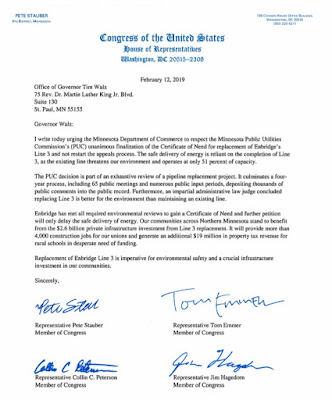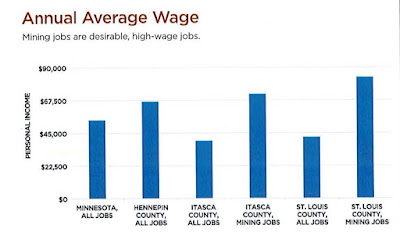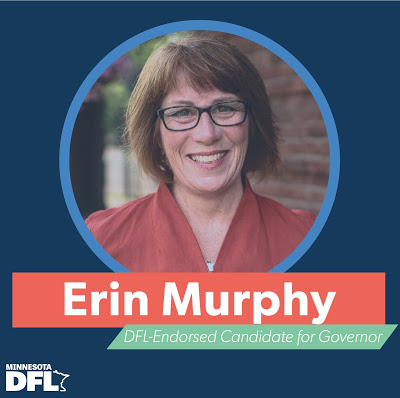Archive for the ‘Environmental Activism’ Category
Salena Zito’s column does a great job highlighting the advantages that Joe Biden has in winning the Democrats’ nomination, then the general election. Personally, I don’t think that Biden’s got any chance in the general election but that’s just my opinion.
Ms. Zito starts by writing “Joe Biden joined the 2020 race for president last week by declaring that the next election will be ‘a battle for the soul of this nation.’ But his decision to make a Western Pennsylvania Teamster hall his first campaign stop on Tuesday shows he truly understands the heart of it.”
I don’t doubt that Biden identifies with western Pennsylvania. It’s just that I think he starts with an albatross around his neck. The name of that particular albatross is President Obama. During their 8 years in office together, the Obama-Biden team tried to demolish the coal industry, the manufacturing industry and the steel industry.
In his announcement video, Biden said that “I believe that history will look back on 4 years of this president and all that he embraces as an aberrant moment in time. But if we give Donald Trump 8 years in the White House, he will forever and fundamentally alter the character of this nation.”
That’s odd considering the fact that the president he served said “We are 5 days away from fundamentally transforming America.”
Sleepy Joe, along with his other Democrat presidential aspirants, sat idly by while President Obama tried destroying steel mill towns, the coal-mining industry and the manufacturing industry. That isn’t the only disturbing thing Obama said. This statement is something else that will live in infamy:
They get bitter, they cling to guns or religion or antipathy to people who aren’t like them or anti-immigrant sentiment or anti-trade sentiment as a way to explain their frustrations.
He was talking specifically about Pennsylvania. Why hasn’t Vice President Biden stepped forward and criticized President Obama for essentially saying that voters in rural Pennsylvania, Ohio and other midwestern states were racists? This might be Biden’s biggest mistake of the campaign.
I don’t doubt that Democrats will let him off the hook for not criticizing President Obama but I’m betting blue-collar Trump voters who felt forgotten under President Obama don’t feel forgotten with President Trump. A major part of President Trump’s accomplishments have benefitted these voters. What reason would they have for leaving the guy whose policies have helped restore their towns and their industries?
I don’t disagree that Biden has some strengths that will help him. It’s just that I think he’s got a ton of liabilities that will hurt him as much as his strengths will help him.
This afternoon, I had a conversation with a long-time reader of LFR on the definition of a DFL moderate. What’s clear to me is that the only DFL moderates, outside of perhaps Collin Peterson, are Democrats running for office. Once they’re into office, they immediately turn into leftists.
A perfect example is Tim Walz. This article highlights Gov. Walz’s leftward turn:
Minnesota Gov. Tim Walz said Tuesday that his administration will keep pursuing an appeal of an independent regulatory commission’s approval of Enbridge Energy’s plan to replace its aging Line 3 crude oil pipeline across northern Minnesota, siding with environmental and tribal groups in his biggest decision since becoming governor last month.
The state Public Utilities Commission approved the project last summer. Then-Gov. Mark Dayton’s Department of Commerce appealed that decision in December, as did several groups opposed to the project. The Minnesota Court of Appeals last week dismissed those appeals as premature and sent the dispute back to the commission for further proceedings. That move forced the Walz administration to take a stand by Tuesday after weeks of studying whether to continue to appeal or let the matter drop.
It’s time to stop pretending that Gov. Walz isn’t bought by the environmentalists. He’s clearly owned by them:
“When it comes to any project that impacts our environment and our economy, we must follow the process, the law, and the science,” Walz said in a statement. “The Dayton administration’s appeal of the PUC’s decision is now a part of this process. By continuing that process, our administration will raise the Department of Commerce’s concerns to the court in hopes of gaining further clarity for all involved.”
Enbridge followed the process that the legislature put in place. Then the environmental activists didn’t get the outcome they wanted. Enter Gov. Bought And Paid For, aka Gov. Walz.
Gov. Walz threw out existing law and went a different direction, though it must be pointed out Gov. Walz’s decision was utterly predictable. The DFL got exactly what it wanted when Walz was elected — a trustworthy leftist in moderate’s clothing.
It isn’t surprising that Gov. Tim Walz has caved to environmental activists. In fact, it’s entirely predictable.
Gov. Tim Walz says his administration will continue to appeal regulatory approval of the Enbridge Energy Line 3 pipeline project in northern Minnesota. State utility regulators last summer approved Enbridge Energy’s plans to build a new $2.6 billion pipeline to replace the aging and corroding Line 3. But, former Gov. Mark Dayton’s Department of Commerce appealed that decision. Walz on Tuesday said his administration will continue that effort.
Gee, I wonder what could’ve caused that cave. Perhaps this?
Last month, more than 50 people, including scientists from the liberal activist group Science for the People, gathered in the governor’s reception room to say the science is clear the Line 3 upgrade will aggravate climate change by facilitating further use of fossil fuels.
Gov. Walz is just as owned by the lefty environmentalists as Gov. Dayton was. No wonder our economy isn’t what it could be.
The Democrats have an impeachment problem. Worse for them, it isn’t going away before the election. That’s because billionaire environmentalist Tom Steyer is “growing his impeach-Trump operation.”
According to the article, “liberal billionaire Tom Steyer claims to be building a juggernaut political operation in support of impeaching President Trump, rallying the base and creating a ‘digital army’ for the cause even as Democratic lawmakers remain publicly divided over the issue. ‘We’re not going away,’ Kevin Mack, the lead strategist at Need to Impeach, told Fox News. ‘We’re going to hold President Trump accountable.'”
The worst part of this is that it’s happening in the closing days of the campaign and Nancy Pelosi doing everything she can to tamp down talk of impeachment until after the election. Pelosi’s ‘Democrat base’ problem is that she can’t turn this off without hurting turnout.
Further, this is precisely the type of thing that’ll be used to create new ads that’ll turn independents away from the Democrats. The NRCC will likely use this in ads in virtually every swing district in America. I’m definitely thinking it’ll be used in MN-8, where President Trump is especially popular.
Democrats are in God’s Little Acre — east of the rock, west of the hard place. They can’t afford not to do what Steyer wants. If they reject him, they lose north of $100,000,000 per cycle in contributions. If they accept, voters reject them. That isn’t a great position to be in.
This pdf article should cause the DFL tons of heartburn. It isn’t a secret that a high percentage of DFL activists are anti-mining. That’s been documented repeatedly on LFR throughout the years. This article, though, is different in that it highlights what’s getting lost in the discussion.
Early in the article, it’s reported that “the state’s mineral resources are largely untouched: the Duluth Complex, a massive rock formation in northeast Minnesota stretching from Duluth to Pigeon Point, holds some of the
world’s largest undeveloped deposits of copper, nickel, platinum group elements (PGE), and ilmenite (the most important ore for titanium). It also contains elements such as cobalt, gold, and silver. If Minnesota had been able to mine these resources in 2017, it would have regained its position as America’s third largest producer of minerals by dollar amount—a position it has not held since 2012. On top of that, these numbers could increase significantly if gold and silver are discovered in mineable quantities in the areas currently being explored in northern Minnesota.”
That’s just the tip of the proverbial iceberg, though. The important information is found a few paragraphs later:
The chart below shows the average annual wage for jobs in Hennepin, Itasca, and St. Louis counties, along with the average of all Minnesota counties. The average annual wage in Hennepin County is approximately $66,600, far larger than the average income for non-mining jobs in northern Minnesota, where wages are $12,000 lower than the state average. Residents of the Twin Cities metropolitan area often take their relatively high wages for granted, but jobs paying more than $66,000 per year are difficult to come by in northern counties. The average income in St. Louis County, for example, is approximately $42,000—and average mining jobs pay $83,235, nearly twice that amount.
Here’s the graph:
The anti-mining wing of the DFL is standing in the way of mining families making a more-than-middle class wage of $80,000+. That’s immoral. That’s before taking into consideration how much these communities need those incomes to rebuild those communities, those neighborhoods, those families, those lives.
Instead of living in poverty, these communities could live in prosperity. Think of the economic growth that’d happen if PolyMet and Twin Metals opened. Then think of how much better off we’d be if we built pipelines and other types of energy infrastructure. Instead of balancing budgets by raising taxes, Minnesota could do something that’s entirely foreign to the DFL. Minnesota could balance budgets through robust economic growth. That’s what it did during the Perpich years. Now, the DFL, the party that gave us Gov. Perpich, hates the people that Gov. Perpich loved.
Richard Painter’s views on copper-nickel mining are pretty typical of the anti-mining wing of the DFL:
The Flambeau Mine, a 35-acre surface mine located just south of Ladysmith in northern Wisconsin, illustrates how the environment and groundwater quality can be protected at an acid-generating mine. Over four years (1993-1997), the Flambeau Mine produced 181,000 tons of copper, 334 ounces of gold, and 3.3 million ounces of silver. At its peak, the mine provided nearly 100 family supporting jobs and paid more than $27.7 million in taxes into a state fund that was returned to the community to promote long-term business development.
Today the closed and restored mine site is an interpretive nature center, a recreation area, and a business park. Reclamation took about two years to complete and cost $20 million, and produced a 150-acre site that includes four miles of nature trails and five miles of equestrian paths that wind their way through a beautifully restored open space.
The anti-mining wing of the DFL says this mining can’t be done safely. Mr. Painter said that in the video. They’re either both wrong or they’re both intentionally lying. Both things seem possible.
Sen. Karin Housley issued this statement urging Congress to “delist the gray wolf as an endangered species.” In the statement, Sen. Housley states “I am pleased the U.S. House of Representatives included an amendment in one of its recently-passed spending bills to bypass the courts and delist the gray wolf as an endangered species. By nearly every metric, the gray wolf’s recovery goals have been exceeded and this language would return management responsibility where it belongs: with the states. Farmers and landowners are prevented from protecting their livestock against wolf attacks because of this burdensome regulation. Instead of siding with far-left environmentalists, Tina Smith should put her brand of radical, left-wing partisanship aside and support this effort in the U.S. Senate.”
By all objective measures, the timber wolf, aka the grey wolf, is no longer an endangered species. Further, it shouldn’t be listed as a threatened species, either. According to this government definition, the definitions of an endangered species and a threatened species are spelled out in simple, easy-to-understand wording. An endangered species “are at the brink of extinction now.” Meanwhile, threatened “species are likely to be at the brink in the near future.” This is important information, too:
Threatened status benefits species and people in two situations: (1) it provides Federal protection before a species reaches the brink of extinction; and (2) in the case of species that were initially listed as endangered, threatened status also allows scaling back Federal protection as they recover and no longer need the maximum protections of the Act.
State natural resource management agencies designated by the Service may “take” (kill, wound, trap, or move as defined by the Act) individuals of a threatened species in pursuit of conservation programs for the species. In contrast, those agencies are prohibited from “taking” an endangered species if the action might kill or permanently disable the specimen, move it to another state, move it beyond its historical range, or keep it in captivity for longer than 45 days.
The environmental activists to which Sen. Housley refers have argued, literally, that species that’ve been put on the endangered species list are forever at risk of extinction. In their mind, the ESA, aka Endangered Species Act, should protect endangered and threatened species alike with equal ferocity.
The thing about environmental activists is that they’re never willing to accept the fact that the ESA worked. If they did, they’d be much less rabid and much more moderate and tolerable.
Now that the Minnesota Public Utilities Commission has said that the Line 3 Pipeline replacement is needed, a new round of litigation is certain to follow. That’s because PUC’s findings “differs from the Minnesota Department of Commerce’s opinion that Line 3 is unnecessary for the state.”
This is what’s wrong with Minnesota’s regulatory system.
According to the article, “The utilities commissioners have many options for what to do regarding Line 3. They could outright deny it, or agree with the staff conclusion and grant a certificate of need. Or they could approve Enbridge’s plan but only under certain conditions. The commissioners could choose some combination of 12 different conditions, such as requiring renewable energy to offset the pipeline’s impact or setting up a fund to remove the old line.”
Or they could choose to throw darts at the report and ignore it entirely. I’m half-kidding, of course. It isn’t surprising that these projects take 10+ years to approve. The market should determine whether a pipeline is required. The last thing we need are a bunch of political busybodies telling us what we need and what we don’t. These aren’t experts. They’re activists with different opinions. Minnesota needs layers of regulators like property owners need arsonists on their payroll.
It’s time to streamline this process so a quick decision can be made. Further, it’s time to call these environmental activists out. They’re putting themselves first instead of putting the country first. Put a different way, these environmental activists aren’t patriots. They should be ashamed of themselves. Period.
I just got off the phone with Mitch Berg, who told me that Erin Murphy has picked Erin Maye Quade to be the Lt. Gov. candidate on her ticket. I told Mitch that nothing says geographical and ideological balance like a pair of gun-grabbing Metrocrats that hate mining. BTW, you’ll want to read Mitch’s upcoming post to hear his perspective on this. Trust me when I tell you that he’s got a perspective that you won’t hear from the Twin Cities media.
Here’s a little background on EMQ: “Quade first rose to prominence in speaking out on sexual harassment at the State Capitol — a #MeToo movement that ultimately led to the resignation of two prominent state legislators. Quade also led a 24-hour sit-in on the floor of the State Capitol in April, calling for a vote on several gun control bills before the session’s end. Quade is the first openly LGBT candidate for statewide office on a ticket endorsed by a major party. At 32, she would also be one of the youngest people to serve in the office.”
In her first gubernatorial-level decision, Murphy failed miserably. The Lt. Gov. must be able to step in as governor if, God forbid, something happens to the governor. Erin Maye Quade fails that test:
Maye Quade is serving her first term in the House and previously worked for U.S. Rep. Keith Ellison doing constituent services and organizing for DFL campaigns. She is a lifelong resident of Apple Valley, where she lives with her wife, Alyse, who also organizes for the DFL Party.
Basically, she’s a high profile activist. What’s funny is that Murphy doesn’t admit that this ticket won’t be well-received outside the Twin Cities metro:
She’s a powerful leader who serves with integrity and authenticity. Representative @ErinMayeQuade and I are ready to keep growing our coalition in every corner of Minnesota and win in November.#TeamErin #mngov #DFL2018 pic.twitter.com/beOtzfCICU— Erin Murphy (@epmurphymn) June 3, 2018
Here’s the thing: Erin Murphy hates farmers almost as much as she hates miners, loggers and gun owners. The thought that Murphy and Quade will appeal to more than 12% of rural voters statewide is ridiculous. I’ve got to think that the NRA is chomping at the bit to go after this ticket. In the Eighth, I’m betting that there are tons of DFLers that can’t wait to vote against this ticket. I wouldn’t be the least bit surprised if they vote for one of the GOP tickets.
Ken Martin won’t admit it but he’s got to be afraid of what this ticket would do to the DFL this November.
Minutes after Tim Walz withdrew from the endorsement fight, the DFL endorsed Erin Murphy to be their gubernatorial candidate.
This was an event-filled, tumultuous, convention. The first shock happened when unknown Matt Pelikan trailed DFL Attorney General Lori Swanson by just 5 points, with Swanson at 52.2% and Pelikan at 47.2% of the vote. Before they started the second ballot, Swanson pulled out, handing the endorsement to Pelikan. When Erin Murphy won the endorsement after Tim Walz withdrew from the endorsement race, rumors started swirling that Swanson might jump into the DFL gubernatorial primary instead of fighting through the DFL AG primary.
Meanwhile, another rumor has it that Ryan Winkler will run in the DFL AG primary if Swanson opts for the DFL gubernatorial primary. If AG Swanson runs in the AG’s primary, she’d probably win. If she runs in the gubernatorial primary, her chances of winning drop significantly. In both instances, though, her chances of winning the general election aren’t that great, though they’d be better if she ran for AG.
As for Murphy’s chances, they aren’t good. If she defeats Tim Walz, she’ll only do so by running far to Walz’s left. Single-payer health care isn’t popular in Minnesota. People didn’t trust MNsure. They definitely won’t trust single-payer. Further, it’s quite possible that she’ll lose to Tim Walz while pushing him farther left than Walz can afford to go to win the general election.
Murphy’s victory makes life difficult for Chairman Martin because it’s dragging the supposed frontrunner farther left than Martin wanted. Next, whoever wins will have gotten dragged so far left that it’ll be virtually impossible to win in November, mostly because Murphy is a hostile environmental activist. To win, she’ll have to alienate miners and union construction workers like pipefitters. Think heavy equipment operators, too.
This isn’t the script the DFL wanted written at convention-end. Most likely, they’ll have primaries in Tina Smith’s seat, the open Nolan seat, the possibly open State AG seat and the governor’s race. It’s the exact opposite of what Chairman Martin hoped for.
Finally, this situation virtually guarantees a Republican governor in November. Add to that the likelihood of Republicans winning the auditor’s race and the definite possibility of Republicans winning the AG race, coupled with the strong likelihood of maintaining their majorities in the Minnesota House and Senate and you’re looking at a pretty difficult year if you’re Chairman Martin. That’s before mentioning the likelihood of winning the First and Eighth U.S. Congressional districts.
This year, Minnesota has none of the makings of a blue wave.
The Trump administration is considering a rule change to something called “the blanket rule.” According to the article, it’s “probably an esoteric issue to most Americans, but to landowners and businesses, primarily in the Western U.S., the ‘blanket’ extension of ESA protections to “threatened” species has punished them for decades. A ‘take’ of a protected species can bring massive civil and criminal penalties. ‘Private property owners’ incentives are key because most endangered species depend on private land for most of their habitat,’ Wood said. ‘This reform will improve those incentives and make it easier for states, property owners, and environmentalists to work together on innovative conservation plans.’ The U.S. Fish and Wildlife Service extended “take” protections to species listed as ‘threatened’ under the ESA, despite Congress wanting federal agents to regulate “threatened” species different from those classified as ‘endangered.'”
When the ESA was enacted, Congress’s intent was to protect endangered species, which is defined as “any species in danger of extinction.” Meanwhile, threatened species are defined as “on the brink of becoming endangered.”
Its provisions give the Interior Department the power to determine what species are endangered and then to list them publicly. It makes it illegal to capture, kill, transport, sell, buy, possess, import or export any of the listed plants or animals. There is a separate category for “threatened” species, those organisms that are on the brink of becoming endangered. They are equally protected, except that scientists may take specimens when necessary for vital research.
In the United States the Office of Endangered Species currently lists 51 plants and 143 animals as endangered and 7 plants and 38 animals as threatened. To prevent the import or trade of endangered species native to foreign countries, the office lists 402 foreign animals as endangered and 16 animals and a plant as threatened.
The goal of the ESA is to properly manage plant and animal species so they’re no longer endangered or threatened.
Here in Minnesota, the ESA was critical in turning around the timber wolf population. At one point (the late 1960s and early 1970s), only a few families of timber wolves existed in Minnesota. After proper management, the timber wolf population, through cautious management, was rejuvenated to the point where there were open hunting seasons on the great grey wolf. That’s a legitimate success story. That should be the goal of management policies for all endangered or threatened species.
Instead, the ESA has been used as a weapon against developers. It’s time to de-weaponized the ESA and return sanity to development projects. That will be a difficult task. Environmental activist organizations like the Sierra Club, Conservation Minnesota and others have used the ESA to throttle projects. They won’t give up without a lengthy court fight.
Rejecting the blanket rule won’t fix the law but it’s a positive first step.






